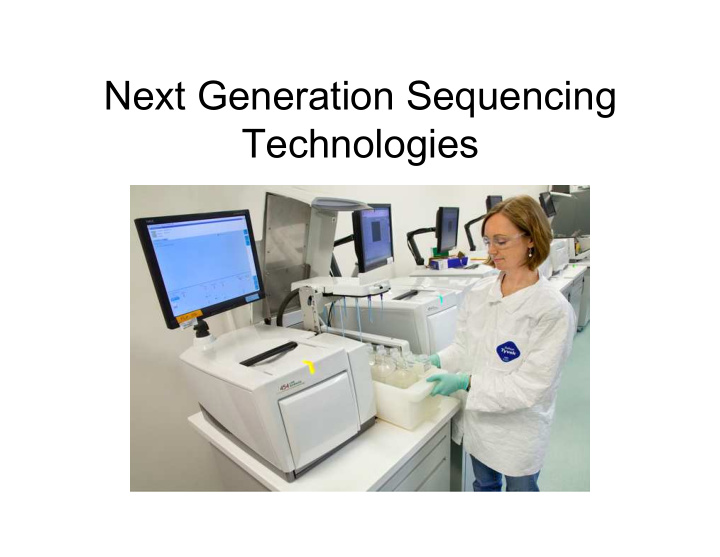



Next Generation Sequencing Technologies
What is first generation? • Sanger Sequencing
DNA Polymerase
Base-adding reaction +H + http://chemwiki.ucdavis.edu/Organic_Chemistry/Organic_Chemistry_With_a_Biological_Emphasis/Chapter_10%3A_Phosphoryl_transfer_reactions/Section_10.4%3A_Phosphate_diesters
Pros and Cons of Sanger Sequencing • Polymerase errors • Can only do 1 average out sequence at a time • Long sequences • Need a lot of DNA to (~450 bp) start with • Expensive: 2¢/base
To solve these cons what do we need? • Cheaper • Multiplex different samples • Smaller starting amount • How might you do this? – What do you need to be able to do?
Design a Sequencer • For 1 minute, write down all the things you would need to do to be able to sequence DNA in a multiplexed way. • Turn to your neighbors (1-2 people) • For 1 minute, discuss the things you would need to do to be able to sequence DNA in a multiplexed way. • Be prepared to tell the class what you think you need and why
What you need to do multiplexed sequencing • Ability to separate individual DNA pieces • Ability to observe the sequence of each separated piece individually • High sensitivity (as compared to Sanger sequencing)
What’s different • Sequence many sequences at once • Technology is paired with DNA sequence agnostic primers • Faster than SS • Shorter than SS
How do we sequence things we don’t know the sequence of?
Adapt sequences with known sequences This can be done with Sanger too, but need to PCR after this to get enough DNA Mardis, ER; Ann Rev Genom & Hum Gen
What you need to do multiplexed sequencing • Ability to separate individual DNA pieces • Ability to observe the sequence of each separated piece individually • High sensitivity (as compared to Sanger sequencing)
Emulsion PCR onto beads (454, Ion Torrent) http://www.nature.com/nrg/posters/sequencing/Sequencing_technologies.pdf
Flow Cell: Bind directly to chip, make bridges (Illumina) Mardis, E. R. (2013). Next-Generation Sequencing Platforms. Annual Review of Analytical Chemistry, 6(1), 287–303. doi:10.1146/annurev- anchem-062012-092628
What you need to do multiplexed sequencing • Ability to separate individual DNA pieces • Ability to observe the sequence of each separated piece individually • High sensitivity (as compared to Sanger sequencing)
454:2005 Imaging and light based http://www.nature.com/nrg/posters/sequencing/Sequencing_technologies.pdf
Illumina: 2006 • Expose to all 4 bases • Add 1 at a time, 3’OH is reversibly blocked • Monitor fluorescence Mardis, E. R. (2013). Next-Generation Sequencing Platforms. Annual Review of Analytical Chemistry, 6(1), 287–303. doi:10.1146/ annurev-anchem-062012-092628 http://www.nature.com/nrg/posters/sequencing/Sequencing_technologies.pdf
As of 2010, all were imaging based • Why might this be problematic? • How else might you follow sequencing?
Ion Torrent: 2010 • On Chips • Most accurate pH meter in the world
Ion Torrent • Expose to single base type at a time • Add as many as possible • Monitor change in pH
Getting DNA onto beads P A P A P P A
Getting DNA onto beads P A
Getting DNA onto beads A A P P P P A Which strand do we keep when we make this single- stranded for sequencing? A
Keep sequence that is complementary to the sequence we read from sequencer A A P P 3’ 5’ P P A A
Actual Sequence on Bead: GTAACTGTCAAACG What happens on Ion Torrent? Cycle through the following bases: T G A C C ATTGACAGTTTGC GTAACTGTCAAACG T G A C TT G A C T G A C T G A C TTT G A C
What does the cyclical process mean for our sequencing? On your sheet, figure out how far each of the sequences will get in 5 cycles
Histogram of read lengths
What is the sequence of the following DNA? TGAC TCTGGTGA
Bead with 2 DNAs ATCTTAGGTA What T happens? T 2x as many C bases as G expected G A A
Errors • Homopolymers AAAAAAA Polymerase adds all at once – System becomes saturated How many are 1 2 3 4 there really of a particular base?
And Now for Something Completely Different Single Molecule Sequencing
Pacific Biosciences: Single Molecule Sequencing (SMRT) Benjamin A Flusberg, Dale R Webster, Jessica H Lee, Kevin J Travers, Eric C Olivares, Tyson A Clark, Jonas Korlach & Stephen W Turner Nature Methods 7, 461 - 465 (2010) Published online: 9 May 2010, doi:10.1038/nmeth.1459 http://www.pacificbiosciences.com/products/smrt-technology/
Pacific Biosciences • Can get VERY long sequences – 5,000-8,000 bases, on average – 30,000 bases sometimes • 99.99% accurate for each base • No averaging, so can find rare SNPs • No amplification needed before sequencing, so less bias • Differences in rates of addition allow one to measure epigenetic variations • Fewer total sequences so generally end up with fewer total bases • Much more expensive than the other techniques
Oxford Nanopore Technologies: In beta-testing Similar potential benefits as SMRT technology, but without drawbacks of polymerase and use of imaging technologies https://www.nanoporetech.com/technology/introduction-to-nanopore-sensing/introduction-to-nanopore-sensing
Oxford Nanopore Technologies https://www.nanoporetech.com/technology/introduction-to-nanopore-sensing/introduction-to-nanopore-sensing
Pros and Cons of NGS • Fast • Fewer reads of each base are combined, • Cheap (<1¢/Mbase) so less accurate • Lots of data overall • Short reads (getting longer, up to ~400 bases now)
Activity • On table: fill in what you think are the pros and cons of each technology we discussed ~ 2 min • Discuss with your neighbors what you each put, generate a consensus list to share with the class ~ 4 min
Questions?
Recommend
More recommend